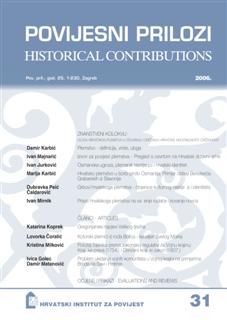Položaj časnika prema zakonskoj regulativi za Vojnu krajinu: Krajiška prava (1754.) i Osnovni krajiški zakon (1807.)
Position of the officers in the Military Border according to the legal regulation: Military Border Rights (1754) and General Military Border Law (1807
Author(s): Kristina MilkovićSubject(s): History
Published by: Hrvatski institut za povijest
Keywords: Military Border; Habsburg Monarchy; legal history; social history; military history; Croatian history – 18th and 19th centuries; officers; modernization; judiciar; landed property
Summary/Abstract: This article discusses changes of the position of officer in the Military Border during the second half of the eighteenth century and at the beginning of the nineteenth century. The investigation was based on the analysis of the legal regulations for the Military Border – Military Border Rights (Militar Gränitz-Rechten) from 1754 and General Military Border Law (Grundgesetze für die carlstädter-warasdiner, banal, slavonische und banatische Militär Grenze) from 1807. The author has analyzed role and position of the officers during the processes of militarization and protomodernization of Croatian and Slavonian Military Border. The included aspects of investigation were military hierarchy, land owning, legal rights and socio-economical position. The main problem of the research was change of status among traditional elites of the Military Border, and related to this author investigated specialization among officers’ strata, which had various consequences. Author has compared positions of higher and lower officers together with the distribution of ranks among “domestic” and “foreign” officers in the Military Border. On the basis of two aforementioned legal sources author defined process of their gradual homogenization that resulted with a recognizable unified social strata. During the investigation author draws attention to the temporary solutions contained in the both documents, which proves that Vienna Court was rather sensible towards population in the Military Border, since these solutions always were a compromise between Court’s projections and Military Border’s reality.
Journal: Povijesni prilozi
- Issue Year: 2006
- Issue No: 31
- Page Range: 161-182
- Page Count: 22
- Language: Croatian

